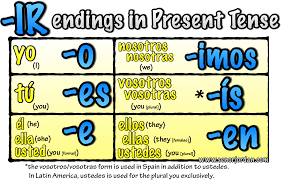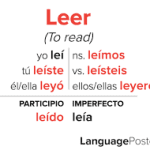Want to learn how to conjugate ‘IR verbs’ in Spanish? Look no further! In this article, we’ll show you the ins and outs of conjugating these verbs in different tenses.
From regular ‘IR’ verb endings to stem-changing and irregular verbs, we’ve got you covered. Get ready to master the art of conjugating ‘IR verbs’ and take your Spanish skills to the next level.
Let’s dive in!
Regular ‘IR’ Verb Endings
To conjugate regular ‘IR’ verbs in Spanish, you’ll use specific endings that indicate the subject and tense of the verb. For example, let’s take the verb ‘vivir’ (to live). If you want to say ‘I live’, you’d say ‘vivo’. Notice how the ‘o’ at the end of the verb indicates the first person singular, present tense.
If you want to say ‘you live’, you’d say ‘vives’. Here, the ‘es’ ending indicates the second person singular, present tense.
It’s important to remember that these endings change depending on the subject and tense of the verb. So, when conjugating regular ‘IR’ verbs, pay attention to the specific endings to accurately express yourself in Spanish.
Stem-Changing ‘IR’ Verbs
Now let’s delve into stem-changing ‘IR’ verbs, which frequently alter the vowel in the stem when conjugated. These verbs follow a similar pattern as regular ‘IR’ verbs, but with a twist. The stem vowel changes in certain forms of the verb, usually in the present tense. Here are some key points to remember about stem-changing ‘IR’ verbs:
- The stem-changing vowel occurs in the second and third person singular forms (e.g., tú, él/ella/usted) as well as the second person plural form (e.g., vosotros/as).
- The stem-changing vowel is typically an ‘e’ or ‘o’, and it changes to ‘ie’, ‘i’, ‘ue’, or ‘u’ respectively.
- Some common examples of stem-changing ‘IR’ verbs include dormir (to sleep), pedir (to ask for), and servir (to serve).
- It’s important to pay attention to the stem-changing vowel when conjugating these verbs to ensure accuracy.
Understanding stem-changing ‘IR’ verbs will greatly enhance your Spanish conjugation skills and help you communicate more effectively.
Conjugating ‘IR’ Verbs in the Present Tense
Let’s talk about conjugating ‘IR’ verbs in the present tense.
To conjugate these verbs, you need to know the verb endings for ‘ir’ and the conjugation rules for ‘ir’.
Understanding these points will help you form correct present tense sentences in Spanish.
Verb Endings for ‘Ir
You can easily conjugate ‘IR’ verbs in the present tense by adding specific verb endings. Here are the verb endings for ‘Ir’ verbs in Spanish:
- Yo: -o
- Tú: -es
- Él/Ella/Usted: -e
- Nosotros/Nosotras: -imos
These endings are added to the stem of the verb to indicate the subject of the sentence. For example, if you want to conjugate the verb ‘vivir’ (to live) in the present tense, you’d remove the ‘ir’ ending from the infinitive and add the appropriate ending for each subject.
So, ‘yo vivo’ means ‘I live’, ‘tú vives’ means ‘you live’, ‘él/ella/usted vive’ means ‘he/she/you (formal) live(s)’, and ‘nosotros/nosotras vivimos’ means ‘we live’.
Conjugation Rules for ‘Ir
To conjugate ‘IR’ verbs in the present tense, follow these conjugation rules for ‘Ir’ while adding specific verb endings to indicate the subject of the sentence.
For regular verbs ending in ‘ir’, such as ‘vivir’ (to live), drop the ‘ir’ and replace it with the appropriate ending.
For example, if the subject is ‘you’, add ‘es’ to the stem ‘viv’. So, ‘vivir’ becomes ‘vives’.
When the subject is ‘he’, ‘she’, or ‘it’, add ‘e’ to the stem, resulting in ‘vive’.
For ‘we’, add ‘imos’ to the stem, making it ‘vivimos’.
If the subject is ‘you all’, add ‘ís’ to the stem, giving us ‘vivís’.
Lastly, for ‘they’, add ‘en’ to the stem, creating ‘viven’.
Conjugating ‘IR’ Verbs in the Preterite Tense
Now let’s move on to conjugating ‘IR’ verbs in the preterite tense. This tense is used to talk about completed actions in the past.
In this conjugation, some ‘IR’ verbs have irregular forms, so it’s important to learn them.
Additionally, there are common conjugations that apply to regular ‘IR’ verbs in the preterite tense.
Irregular ‘Ir’ Verbs
When conjugating IR verbs in the preterite tense, it’s important to be aware of irregular ‘Ir’ verbs. These verbs don’t follow the regular conjugation patterns and require special attention. Here are some irregular ‘Ir’ verbs in the preterite tense:
- Decir: Dije, dijiste, dijo, dijimos, dijisteis, dijeron (I said, you said, he/she said, we said, you all said, they said)
- Traer: Traje, trajiste, trajo, trajimos, trajisteis, trajeron (I brought, you brought, he/she brought, we brought, you all brought, they brought)
- Venir: Vine, viniste, vino, vinimos, vinisteis, vinieron (I came, you came, he/she came, we came, you all came, they came)
- Hacer: Hice, hiciste, hizo, hicimos, hicisteis, hicieron (I did/made, you did/made, he/she did/made, we did/made, you all did/made, they did/made)
Remember to memorize the conjugation of these irregular ‘Ir’ verbs to accurately use them in the preterite tense.
Common Preterite Conjugations
After learning about the irregular ‘Ir’ verbs in the preterite tense, let’s now explore the common conjugations for ‘IR’ verbs in the preterite tense.
When conjugating regular ‘IR’ verbs in the preterite tense, you simply need to remove the ‘IR’ ending and replace it with the corresponding preterite endings.
For example, the verb ‘vivir’ (to live) becomes:
- ‘viví’ for ‘I lived’
- ‘viviste’ for ‘you lived’
- ‘vivió’ for ‘he/she/it lived’
- ‘vivimos’ for ‘we lived’
- ‘vivisteis’ for ‘you all lived’
- ‘vivieron’ for ‘they lived’.
Other common ‘IR’ verbs like ‘escribir’ (to write) and ‘recibir’ (to receive) follow the same pattern.
Remember to pay attention to the subject pronouns and choose the correct ending accordingly.
Conjugating ‘IR’ Verbs in the Imperfect Tense
To conjugate ‘IR’ verbs in the imperfect tense, you’d use an article determiner and follow the second person point of view, active voice, and contractions. These are the steps you should follow:
- Start with the subject pronoun, such as ‘tú’ (you).
- Drop the -ir ending from the verb.
- Add the appropriate imperfect ending based on the subject pronoun.
- Use contractions when necessary, such as adding an accent to avoid two vowels in a row.
For example, if you want to conjugate the verb ‘vivir’ (to live) in the imperfect tense for ‘tú,’ you’d say ‘tú vivías’ (you used to live).
Remember to practice these conjugations to become more familiar with them.
Conjugating ‘IR’ Verbs in the Future Tense
Now let’s talk about how to conjugate ‘IR’ verbs in the future tense.
In this tense, you’ll use the same verb endings for all ‘IR’ verbs.
The most common ‘IR’ verbs include vivir (to live), escribir (to write), and abrir (to open).
Common ‘IR’ Verbs
You’ll master conjugating ‘IR’ verbs in the future tense by learning common examples. Here are some commonly used ‘IR’ verbs that you should familiarize yourself with:
- Dormir (to sleep):
- dormiré (I will sleep)
- dormirás (you will sleep)
- dormirá (he/she/it will sleep)
- dormiremos (we will sleep)
- dormiréis (you all will sleep)
- dormirán (they will sleep)
- Vivir (to live):
- viviré (I will live)
- vivirás (you will live)
- vivirá (he/she/it will live)
- viviremos (we will live)
- viviréis (you all will live)
- vivirán (they will live)
- Partir (to leave):
- partiré (I will leave)
- partirás (you will leave)
- partirá (he/she/it will leave)
- partiremos (we will leave)
- partiréis (you all will leave)
- partirán (they will leave)
- Sentir (to feel):
- sentiré (I will feel)
- sentirás (you will feel)
- sentirá (he/she/it will feel)
- sentiremos (we will feel)
- sentiréis (you all will feel)
- sentirán (they will feel)
Remember to practice these verbs to become more confident in conjugating ‘IR’ verbs in the future tense.
Verb Endings
To conjugate ‘IR’ verbs in the future tense, you’ll need specific verb endings. These endings are the same for all ‘IR’ verbs, regardless of the verb’s subject.
To form the future tense of ‘IR’ verbs, simply add the corresponding endings to the infinitive form of the verb. For example, let’s take the verb ‘vivir’ (to live). The infinitive form is ‘vivir’. To say ‘You will live’ in Spanish, you’d say ‘tú vivirás’. Here, the verb ending ‘-ás’ is added to the infinitive ‘vivir’.
Similarly, for other subjects, such as ‘él’, ‘ella’, or ‘usted’, the ending ‘-á’ is used.
Conjugating ‘IR’ Verbs in the Conditional Tense
To conjugate ‘IR’ verbs in the conditional tense, simply use the second person singular form of the verb followed by the endings -ía, -ías, -ía, -íamos, -íais, or -ían. For example, if you want to say ‘you would open’ in Spanish, you’d use the verb abrir (to open) and conjugate it as abrirías.
Here are the endings for ‘IR’ verbs in the conditional tense:
- ía
- ías
- ía
- íamos
- íais
- ían
Irregular ‘IR’ Verbs
When conjugating irregular ‘IR’ verbs in Spanish, use the second person singular form of the verb followed by the appropriate endings. These verbs have slight changes in their stems, which affect the conjugation in the second person form.
For example, the verb ‘venir’ (to come) changes its stem to ‘vien-‘ in the second person singular form. So, instead of saying ‘tú vinas’ (you come), you say ‘tú vienes’ (you come).
Similarly, the verb ‘dormir’ (to sleep) changes its stem to ‘duerm-‘ in the second person singular form. Instead of saying ‘tú duermas’ (you sleep), you say ‘tú duermes’ (you sleep).
It’s important to pay attention to these stem changes when conjugating irregular ‘IR’ verbs in Spanish.
Common ‘Ir’ Verbs and Their Conjugations
To conjugate common ‘IR’ verbs in Spanish, you’ll use the second person singular form of the verb followed by the appropriate endings. Here are four common ‘Ir’ verbs and their conjugations:
- Vivir (to live)
- Tú vives (you live)
- Dormir (to sleep)
- Tú duermes (you sleep)
- Salir (to go out)
- Tú sales (you go out)
- Decidir (to decide)
- Tú decides (you decide)
Remember, these conjugations are specific to the second person singular form. By learning and practicing the conjugations of these common ‘Ir’ verbs, you’ll be able to express yourself more accurately in Spanish.
Keep practicing and soon you’ll be able to conjugate ‘Ir’ verbs with ease.
Tips for Mastering ‘IR’ Verb Conjugation
For mastering ‘IR’ verb conjugation in Spanish, use the preposition ‘con’ to connect the second person singular form of the verb with the appropriate endings. This technique will help you consistently conjugate ‘IR’ verbs correctly.
Start by taking the stem of the verb, which is the infinitive form without the ‘IR’ ending. Then, add the appropriate ending depending on the subject pronoun and tense you’re using.
For example, if you want to say ‘you go’ in the present tense, you’d start with the stem ‘v-‘ and add the ending ‘-as’ to get ‘vas.’
Remember to also pay attention to any spelling changes or irregularities that may occur.
Practice regularly and soon you’ll become comfortable with conjugating ‘IR’ verbs in Spanish.
Frequently Asked Questions
What Are Some Common Mistakes Made When Conjugating ‘Ir’ Verbs in Spanish?
When conjugating ‘ir’ verbs in Spanish, some common mistakes you might make include forgetting to change the verb ending based on the subject and not using the correct verb form for each tense.
Can ‘Ir’ Verbs Have Irregular Endings in Certain Tenses?
Yes, ‘ir’ verbs can have irregular endings in certain tenses. It’s important to learn these irregularities to properly conjugate them. Pay attention to the stem changes and endings specific to each verb.
Are There Any Exceptions to the Regular Conjugation Rules for ‘Ir’ Verbs?
Yes, there are exceptions to the regular conjugation rules for ‘ir’ verbs. Some verbs, like ‘venir’ and ‘tener’, have irregular conjugations in certain tenses. But don’t worry, they can be learned!
How Can I Remember the Different Stem Changes for ‘Ir’ Verbs?
To remember the different stem changes for ‘ir’ verbs, practice regularly and create flashcards. Repeat the conjugations out loud and use them in sentences. Consistency and repetition will help you master the changes.
Are There Any Strategies for Practicing and Improving My Conjugation Skills With ‘Ir’ Verbs?
There are several strategies you can use to practice and improve your conjugation skills with ‘IR’ verbs. One way is to create flashcards and quiz yourself regularly. Another way is to write sentences using ‘IR’ verbs in different tenses. Keep practicing!
Conclusion
In conclusion, conjugating ‘IR’ verbs in Spanish requires understanding the regular and irregular verb endings, as well as stem-changing patterns.
It’s important to practice conjugating verbs in different tenses, such as the present, preterite, imperfect, and conditional.
By familiarizing yourself with common ‘IR’ verbs and their conjugations, you can improve your Spanish language skills.
Remember to use contractions to make your speech more natural and fluent.
With practice and dedication, mastering ‘IR’ verb conjugation is achievable.


